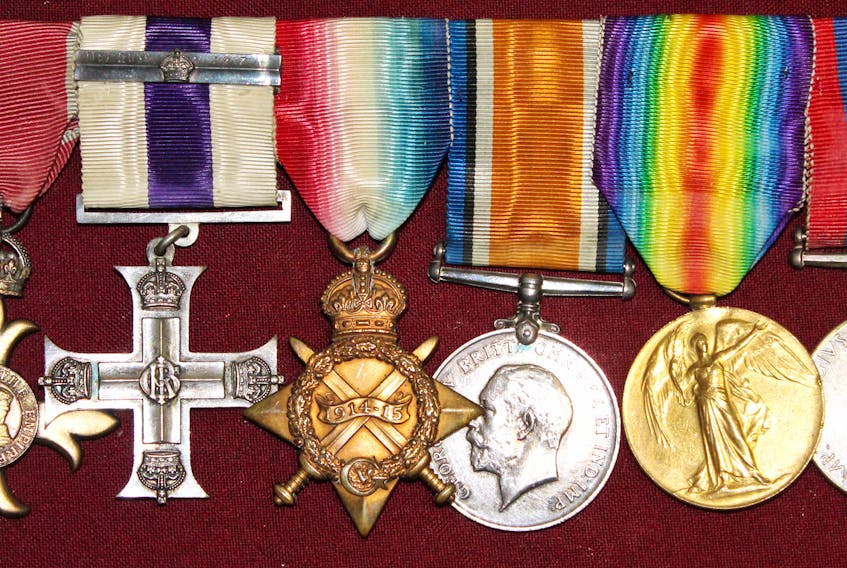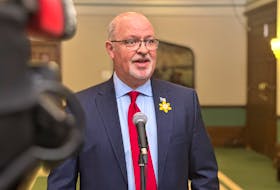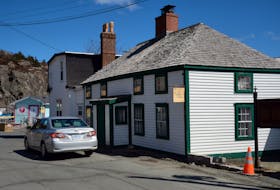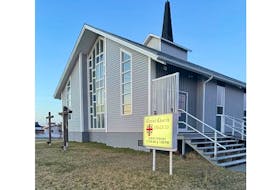A unique set of war medals awarded to Major R. Grant Patterson, one of the legendary Blue Puttees, was recently donated to the Royal Newfoundland Regiment Museum.
During the commemoration of the 100th anniversary of the Battle Of Cambrai, Patterson’s bravery was recounted along with that of many other Newfoundlanders.
According to Chris Butt, the medal expert at the museum, two things in particular make this an exceptional donation to the museum’s already outstanding collection of war medals.
Patterson has the distinction of being the only soldier to be decorated for service with the Newfoundland Regiment in both world wars, twice for bravery in the First World War and again for meritorious service in the Second World War.

In addition, in the First World War, Patterson was the only officer who was attached to the fighting unit of the regiment, the 1st Battalion, at the time it won each of its battle honours.
His is a truly unmatched record of service.
Patterson, then 19, enlisted in the regiment as a private in September 1914 and went overseas with the famous First 500. He rose through the ranks quickly, receiving an officer’s commission as a 2nd lieutenant in April 1915.
By December 1915, he was leading soldiers in the field with the 1st Battalion at Gallipoli after his promotion to lieutenant. On the most tragic day in the regiment’s history, July 1, 1916, he was one of the 25 officers, all of whom were either killed or wounded, who went over the top at Beaumont Hamel.
Patterson was among the more fortunate, wounded only in one hand. After a short convalescence in Britain, by early September he was back with the 1st Battalion for the regiment’s first major battlefield victory at Gueudecourt in October.
After the regiment distinguished itself at Monchy-le-Preux in April 1917, Patterson was appointed officer commanding “C” company and promoted to captain. At the regiment’s next major engagement attacking the German lines at Steenbeek in Belgium in August 1917, Patterson was awarded the Military Cross, a gallantry medal only for officers, for the great skill, coolness and judgment he showed in forming up the battalion in readiness for the attack and for leading his company to capturing their objective.
Just three months later at the Battle of Cambrai, Patterson was awarded a second Military Cross for his role in the regiment’s Nov. 20 attack on the St. Quentin Canal, the crossing of which was a key objective of the entire British battle strategy.
Patterson was cited for his gallantry in leading an attack that captured the canal bridge. When heavy enemy fire disorganized the attack after crossing the bridge, he showed great energy and determination in reorganizing his men and continuing the advance.
In so doing, Patterson became one of the most decorated officers to serve with the regiment. Out of about 150 officers in total who led regiment soldiers on the battlefield, only 30 received the Military Cross. Of those 30, only six were awarded it twice — one of those being Patterson.
Patterson remained attached to the 1st Battalion for another year until he was wounded a second time, this time in the leg, on Oct. 14, 1918 at Ledeghem, the same day Tommy Ricketts won the regiment’s only Victoria Cross.
As a result of his wound, Paterson was sent to hospital in London to recuperate.
Butt of the regiment museum has done an analysis of the regiment’s officer corps to understand how the perils and strain of leading soldiers on the battlefield affected their ability to continue serving in the field.
No other officer serving with the 1st Battalion had near the length of field service Patterson attained. Given the attrition rate of other officers, it is quite remarkable how he was able to endure the trying conditions of life in the trenches for so long.
“Another way to put Patterson’s service in perspective is to look at the battle honours awarded to the regiment,” Butt said.
“There was a detailed process of application and assessment for a regiment to be formally awarded a battle honour. Regiments were further limited in the battle honours they could emblazon on their regimental colour (flag). The Royal Newfoundland Regiment was awarded 16 First World War battle honours, 10 of which the regiment was permitted to emblazon on its flag,” he added.
Patterson is the only officer who was attached to the fighting unit of the regiment, the 1st Battalion, at the time the regiment earned each of those battle honours. The record of service represented by his Great War medal group alone is remarkable and unique.
Second World War
But his medal group not only represents First World War service.
Still a young man in his mid-20s when the First World War ended, he was in his early 40s when the Second World War commenced.
It was thought at that time there was a much greater risk that war could be brought to the shores of Newfoundland. The Royal Newfoundland Regiment had been disbanded in 1919, so part of Newfoundland’s response to the outbreak of the Second World War was to again ask for volunteers for military service — including for home defence — in what was first called the Newfoundland Militia and evolved into the Newfoundland Regiment.
While Newfoundland’s primary contribution to overseas service in the First World War was the famed infantry regiment, in the Second World War Newfoundland’s primary overseas contribution was two Royal Artillery regiments, the 166th Field regiment and the 59th Heavy regiment.
The role of the Newfoundland Regiment in the Second World War was to contribute to the defence of the dominion and to serve as a holding battalion where soldiers who volunteered for overseas service received their initial training.
A number of soldiers who had served with the regiment in the First World War volunteered again, including Patterson, initially a captain in the home defence Newfoundland Regiment, and subsequently promoted to major and second-in-command of the unit.
Patterson served from 1940 until the end of the war.
Generally, one of the responsibilities of the second-in-command is for training, and in this role Patterson would have come in contact with many Newfoundland volunteers for overseas service.
As he had demonstrated his devotion to duty in the First World War, he did so again in the Second World War.
At the end of the war, a handful of soldiers who served with the Newfoundland Regiment on home service were decorated for their contribution to the regiment and the war effort.
Patterson, for his meritorious service, was made an Officer of the Order of the British Empire, an OBE, and the medal he received for this is included in the donated group.
This award makes the Paterson medal group unique.
It is the only medal group of a soldier who served with the Newfoundland Regiment as they were constituted in both world wars to include decorations for outstanding service in both conflicts.
NOTE: The Royal Newfoundland Regiment Museum expresses its gratitude to the family of the late Dr. W. David Parsons, the pre-eminent historian of the regiment before his passing in 2016, for this magnificent donation in his memory to the museum collection.
With files from Chris Butt, Royal Newfoundland Regiment Museum









